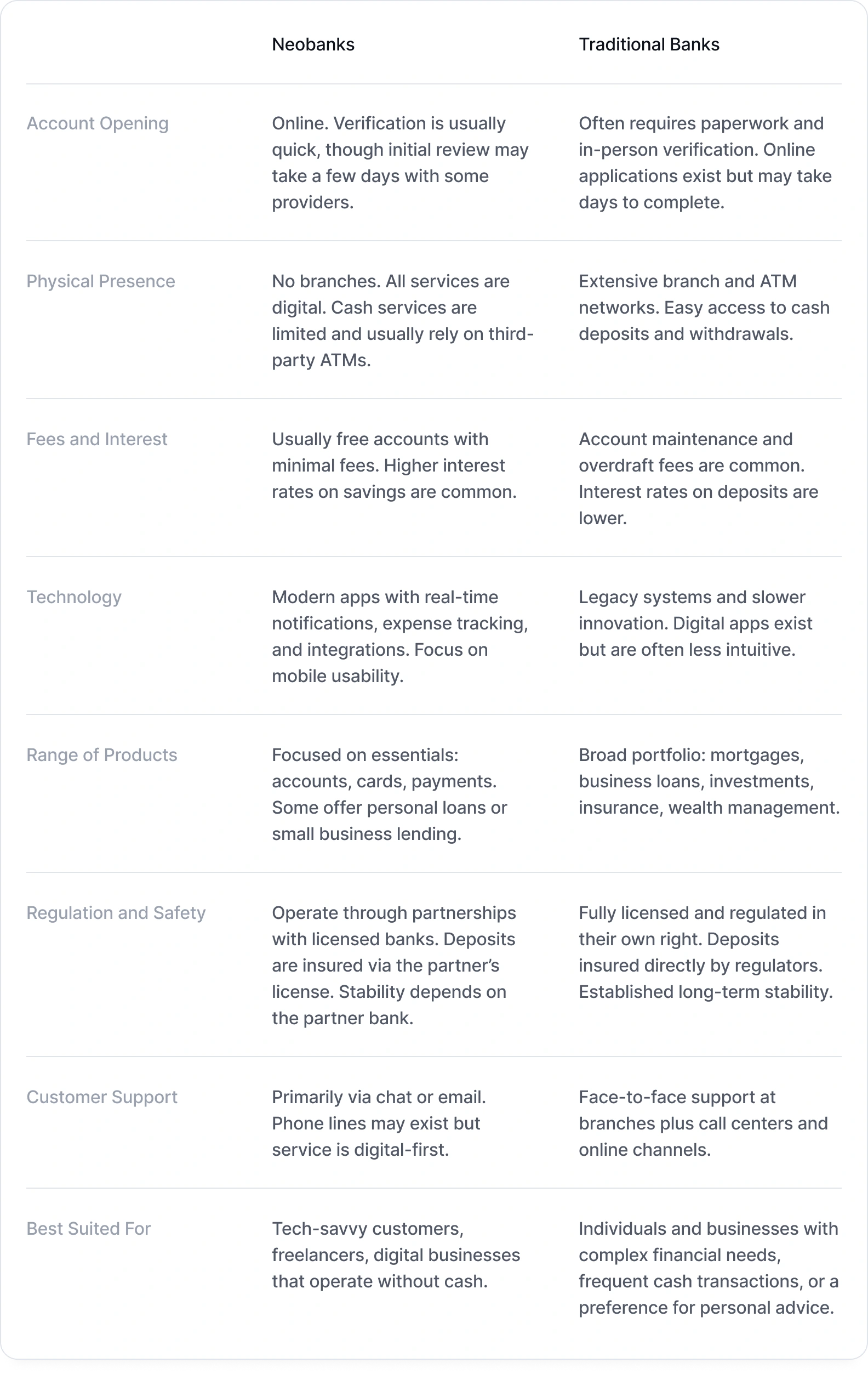
Neobanks vs Traditional Banks: Advantages, Drawbacks, and Main Differences
For many founders and business owners, banking is no longer a simple choice. The rise of neobanks has introduced digital-first alternatives that compete directly with traditional banks. In this article we explain in clear terms how neobanks work, how they compare with established institutions, and what you should weigh before deciding which route to take.
What Are Neobanks?
Neobanks are digital-first institutions that focus on simplicity, technology, and low costs. Unlike traditional banks, they usually don’t operate branches, which allows them to cut expenses and offer customers better terms such as no-fee accounts or higher interest on deposits.
Most neobanks don’t hold a full banking license. Instead, they operate under a partner bank’s license, which covers deposits, insurance, and compliance. This lets neobanks focus on product and user experience, while only a few pursue their own licenses to gain more independence but also face stricter regulatory demands.
For the customer, this partnership is often invisible. You open an account in a sleek mobile app, go through a quick digital verification, and within minutes you are ready to send or receive money. Neobanks tend to provide real-time notifications, automated savings tools, and integrations with other financial services. This is why they are popular with freelancers, digital nomads, and entrepreneurs who want fast, mobile-only access to their finances.
If you want to see which neobanks are most relevant right now for startups in the U.S., check out Skala’s guide to the top neobanks for 2025.
How Do Traditional Banks Operate?
Traditional banks are what most of us grew up with: institutions that combine branches, ATMs, and a wide network of services. They are directly licensed by regulators and can issue loans, provide mortgages, and offer investment products. Their size and history give them credibility and trust, which is why individuals and businesses often turn to them for complex financial needs.
However, these advantages come with costs. Traditional banks typically charge account maintenance fees, overdraft fees, and transaction fees. Their technology platforms are sometimes outdated, which can make digital services slower and less user-friendly compared to neobanks. At the same time, their branch infrastructure makes them accessible for anyone who prefers in-person support, especially when dealing with large sums of money, legal contracts, or complex credit arrangements.
Comparing Neobanks and Traditional Banks
To better understand the real differences, let’s look at how neobanks and traditional banks approach the fundamentals. Neobanks emphasize speed, low cost, and digital convenience, while traditional banks offer stability, a wider range of services, and personal support.

Pros and Cons of Neobanks
Pros
- Cost efficiency. Lower overheads allow neobanks to offer cheaper services and pass savings to customers.
- User experience. Designed mobile-first, with intuitive apps and seamless digital workflows.
- Innovation speed. Quicker adoption of new payment methods, integrations, and fintech features.
- Accessibility for entrepreneurs. Ideal for founders and freelancers who operate globally and don’t rely on cash.
Cons
- Limited depth. Fewer financial products compared to full-service banks (e.g., complex credit, wealth management).
- Reliance on partners. Many neobanks depend on licensed banks for compliance and insurance, which can confuse customers.
- Uncertain long-term stability. Some neobank models are still untested, raising questions about sustainability.
- Not cash-friendly. Businesses with heavy cash operations may find them impractical.
Strengths and Weaknesses in Practice
When entrepreneurs ask whether neobanks are better, the answer is that it depends on what you need. Neobanks excel at speed, convenience, and affordability. If you want to open an account during your lunch break and immediately start accepting payments, they make that possible. Their apps are built for mobile lifestyles, offering clean design, instant notifications, and budgeting tools that traditional banks rarely match.
But neobanks come with trade-offs. The absence of physical branches can be a deal-breaker if you regularly handle cash. Their range of services is narrower, which means that when you need a business loan or a mortgage, you may have to turn to a traditional bank anyway. Some entrepreneurs worry about their long-term stability, since many neobanks are still startups operating on slim margins.
Traditional banks, on the other hand, offer the full spectrum of financial products under one roof. They are heavily regulated and have long track records, which makes them safer in the eyes of conservative customers and investors. Their weaknesses lie in their cost structure (high fees and rigid processes) and in the fact that their digital tools often lag behind.













